By Jeffrey A. Rendall, Images Courtesy of Callaway Golf CARLSBAD, CA – The mystery of flight. Humans tried for centuries to discover the secret, and then it seems the 1900’s revealed the answers, in many different forms.
We’re not just talking about airplanes, either. The game of golf also took to the air after hundreds of years on the ground, with 20th century courses requiring carries over trouble, greens demanding approaches from above and equipment manufacturers looking to the skies to provide that needed extra bit of height for your golf game. |
|
Whereas golf was originally meant to be played on the ground, time and philosophical evolution has shifted much of the focus towards the heavens. Sure, you can still play on the ground, but if you’re not moving it yards instead of inches at a time, you’re losing more than mere distance.
You’re missing the point.
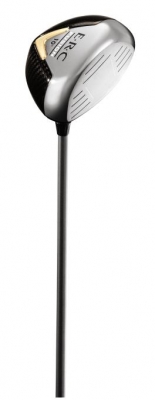 |
If you’re looking to solve that ‘mystery of flight,’ try the Callaway ERC Fusion Driver and the Callaway HX Tour Golf Balls. In the golf world of high-tech, the folks at Callaway are going one step further, employing space age materials and theories to help golfers get that added bit of ‘air’ from their golf shots. And here you thought it was just bigger driver heads and solid core golf balls that were making the difference.
Well, it is – but it’s also the ‘stuff’ that goes into those clubs and balls.
Alan Hocknell, Callaway’s Senior Director of Product Design and Engineering, says the ERC Fusion Driver is the company’s most advanced golf club yet: “When we’re talking about the ERC Fusion, it’s our best technological effort and most difficult and complicated driver we’ve ever made – and we spent several years developing it. We’ve taken the best elements of the original ERC and ERC II drivers and developed them further. You’ve got the combination of a hot face for distance and different body technologies for forgiveness.”
“It’s without a doubt the most forgiving driver we’ve come out with, and probably the most forgiving driver on the market. The ERC Fusion is an engineering achievement as much as anything else – I’m not sure people really appreciate just how difficult it is to make,” added Hocknell, proudly.
That’s quite a statement, considering every manufacturer’s laying claim to the title of forgiveness champion, and likewise, every club designer says they’ve got the technical specs that reveal those closely guarded secrets of flight.
 |
From an unbiased observer who’s used several of the best and latest, the Callaway ERC Fusion’s up there with the top tier, though I won’t rank it above or below the others, at least in a scientific sense. It’s a darn nice club, one I’d recommend if you asked, though.
Our job is to tell you why it’s so good, and why it’s different. Hocknell helps in this regard: “The thing that’s different about the ERC Fusion is – we’ve freed ourselves from the somewhat confining material properties of Titanium. We still use Titanium in the face, but we’ve also introduced a second material, Carbon Fiber, which has better strength-to-weight properties than Titanium.”
“We’ve computer simulated and analyzed the head and impact points -- and discovered where it’s most appropriate to use which material. Most of our competitors use strictly Titanium, which won’t allow for the same kind of flexibility in weight redistribution,” Hocknell the engineer, lectured.
Having lived through the Titanium revolution in the past decade and change, are we in for a ‘Carbon Fiber’ movement as well?
It’d help if we knew what it was. “Carbon Fiber’s a laminate structure, so it’s made up of layers of fibers – with each layer oriented in a different direction,” Hocknell continued. “Those fibers and different layers and different directions combine under heat and pressure to fuse into one structure. Overall, it’s light, tough and strong.”
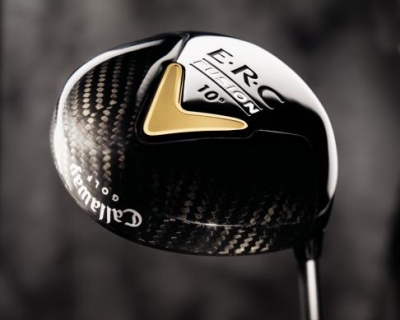 |
And it’s not completely unique to the ERC Fusion – it was used in Callaway’s C4 driver prior to it. Carbon Fiber’s an aerospace grade material, so it’s also used by commercial and military aircraft manufacturers in piecing together large sections of aircraft (more flight allusions?).
As previously mentioned, because Carbon Fiber’s so light and strong, it allows for weight redistribution in the driver head. Hocknell takes it from here: “By putting this lightweight material in the back of the head – it’s essentially made the ‘saved’ weight available to our design team to use at their discretion, anywhere inside the hollow head.”
The ERC Fusion has more ‘discretionary weight’ to move around than most other drivers. If the average driver head weighs 200 grams, employing the Carbon Fiber material allows for about one-quarter of that weight to be moved around – which is significantly more than normal, whereas usually less than 10% is available for redistribution.
Hocknell said they’ve put the ‘free’ grams on the perimeter of the head, as far away from the center as possible – which makes the head very stable. Stability means straighter shots that curve less. Callaway’s engineers have also distributed extra weight in certain locations to precisely position the center-of-gravity of the head. This varied placement produces different ball flights based on a golfer’s individual characteristics.
In other words, double reinforcement for longer and straighter tee shots. What else would you ask for from a driver?
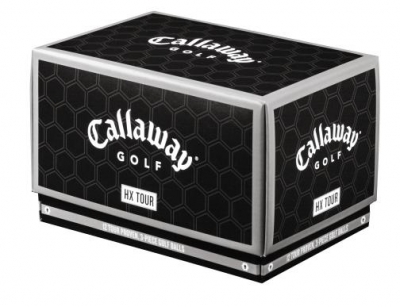 |
A final observation on the ERC Fusion – it doesn’t necessarily follow the ‘size matters’ line of thinking when it comes to driver heads. Hocknell explains: “The ERC Fusion has a 360cc head (460cc is the USGA set limit, and many companies are producing drivers of that size), and we decided that we didn’t need to make it bigger because the club actually plays much larger than its real volume.”
How, you ask?
“The discretionary weight on the perimeter of the head increases the moment-of-inertia, the stability of the head, to the equivalent of a head 60cc’s larger. So we felt we could create a relatively compact, friendly looking shape that will give people a lot of confidence and still play a lot larger than its actual size,” Hocknell said.
Callaway says the ERC Fusion is suitable for all types of players, from Tour professionals to high handicappers (because of the ease of getting the ball in the air) – of course, with the caveat of proper fitting involved.
Hocknell says it’s particularly important to find the proper loft for your swing (because that determines where the weight’s redistributed to), and he highly recommends taking the club out onto the course to discover the club’s benefits rather than merely banging balls into a golf shop’s net.
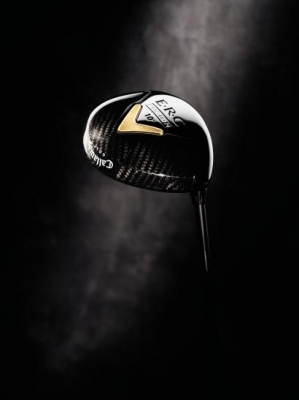 |
So find a shop that will let you demo the club for a round or two (try Callaway’s website for locations). That’s highly recommended for this or any golf club that you’re going to invest good money in.
As we discovered, there’s more to the Callaway ‘flight’ story than just the ERC Fusion. Having seen a few of its HX Tour golf balls around the course, we thought it looked like something we’d want to look further into. We weren’t disappointed with the curiosity, either.
It turns out the Callaway HX Tour ball has its connections to the aerospace industry as well. Mike Yagley, Callaway’s Vice President of Product Management for Golf Balls, says it’s all in the shapes: “If you hold up the HX Tour to any other golf ball, you’ll notice it doesn’t have the typical circular dimples that golf balls have always used – it’s got a series of hexagons and a few pentagons on the ball.”
On further examination, the shapes are different. How bizarre.
Yagley continues, “Our aerodynamicist, Steve Ogg (who used to be an engineer with Boeing until leaving for Callaway in August, 1997), looked at why dimples were round in the first place. From an aerodynamics standpoint, the work being done by the ball on the air to reduce drag is done primarily by the edge of the dimple, because that’s what you call a transition in the surface.”
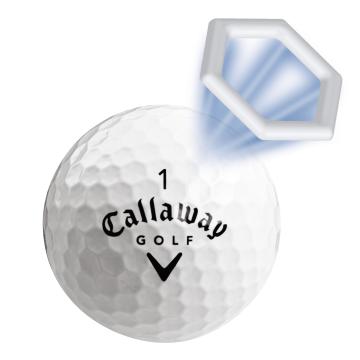 |
Aerodynamics, drag, air, dimples. High School Physics all over again. Yuck.
Luckily, the story’s much more interesting than that. “If you didn’t have dimples, you’d have a perfectly smooth sphere with a large wake behind the ball – hence, a lot of drag, and it wouldn’t fly very far,” Yagley said.
Ogg looked at why you’d need circular dimples in the first place, because when you put three or four or five of them together, there’s a ‘land’ area in between ‘em where there really isn’t anything. What a ‘drag’ for the golf ball.
The HX Tour takes care of that, with Ogg literally connecting the dots between land areas around the dimples, instead drawing straight lines – creating a series of hexagons and pentagons on the ball instead of round dimples.
Presto – the ball’s more efficient aerodynamically, stays in the air longer – and you get more distance. Yagley said the new pattern reduces drag, and also optimizes the lift on the ball a little more. Bottom line, it flies better. Again, solving the mystery of flight.
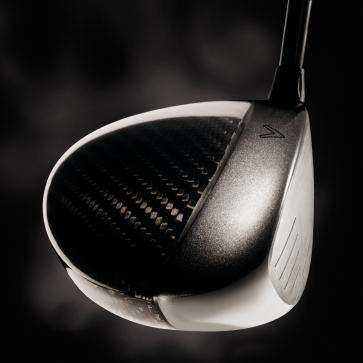 |
That’s not all – you’re able to control the direction and distance of the flight because of what’s on the inside. The HX Tour is a three-piece ball, consisting of a core, a boundary layer and an extremely thin urethane cover.
Yagley describes it this way: “Imagine taking a really good two-piece ball (that’s essentially long and doesn’t spin much around the greens) and putting a really thin, very soft urethane cover over the top of it. Urethane’s a lot like rubber in feel, and a heck of a lot more pliable than plastic (ionomer, the plastic-like cover on most two-piece balls) – it’s soft, real springy.”
“So you put an extremely thin urethane layer on there because it adds a little bit of improved feel, but more importantly, adds spin around the greens – because you’ve got this soft layer on the outside, you can spin the heck out of it,” Yagley added.
The ball turned out so well, in fact, the first ones to try it were the first ones who wanted it.
“We gave it to our Tour professionals last May (’03). We knew we had a good golf ball, but we didn’t anticipate them saying they wanted to play it immediately,” Yagley said, somewhat astonished.
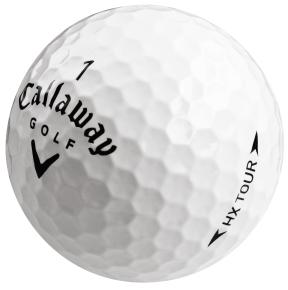 |
He continues, “We had enough to supply the PGA Tour and the other Tours by the end of June last year – and about 70% of them switched to it right off, which shocked us, because it was in season. Most of the time, when these pros find a ball they like, it’s difficult to even get ‘em to try a new product, let alone switch to it while they’re still playing tournaments. But they did, because they found this ball is longer than anything they’ve played – and they all want to go longer.”
Ain’t that the truth. It seems we’re obsessed with length these days. I’ve enjoyed playing the Callaway HX Tour golf ball, finding it to be long and particularly accurate. Together with the ERC Fusion driver, keeping the ball in play is easy, and I don’t worry too much about clearing forced carries (I don’t with the other premium balls either, to be fair).
Certainly worth a try – as always, compare with the others, and you’ll find a combination that works for you.
If you do, then perhaps the mystery of flight will be yours for the solving.
Details:
Callaway ERC Fusion Driver and HX Tour Golf Balls
Available at your higher-end golf retailers and club pro shops.
Check out more information about Callaway Golf products at: www.callawaygolf.com, including locations to demo and purchase products.
| Related Links | Comments on this article? | |
|
Maryland National Golf Club Hollow Creek Golf Club Rocky Gap Resort PB Dye Golf Club in Ijamsville Whiskey Creek Golf Club |
E-mail Jeff Rendall, Editor: jrendall@golftheunitedstates.com |













